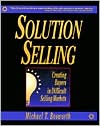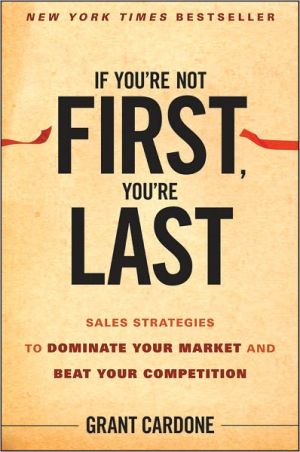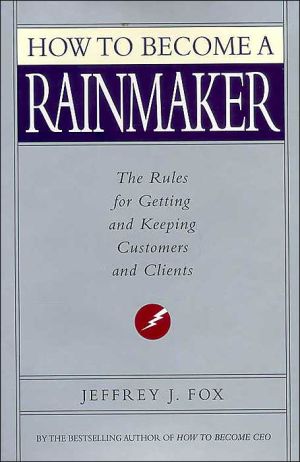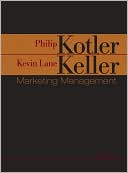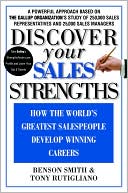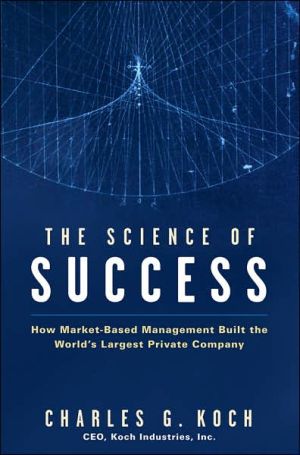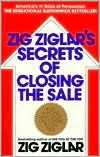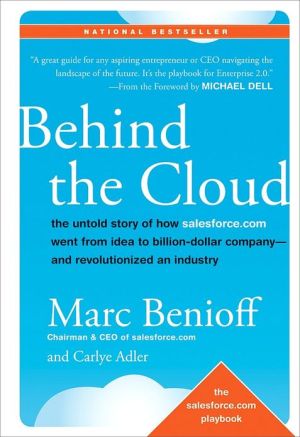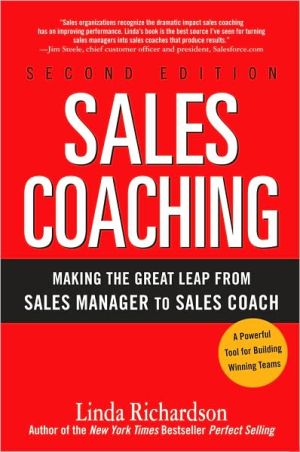Solution Selling: Creating Buyers in Difficult Selling Markets
''Solution Selling is the most comprehensive sales and sales management process available today. Mike Bosworth has the best understanding of sales process in corporate America.''Jeffrey M. Fisher, Vice President, Symix Computer Systems.\ \ \ In this age of rapidly-advancing technology, sales professionals need a reliable method for selling products and services that are perceived as sophisticated or complex. This book offers techniques for overcoming the customer's...
Search in google:
Solution Selling is a process to take the guesswork out of difficult-to-sell, intangible products and services. It enables sellers to make the way they sell as big an advantage as their product or service. After reading this book, salespeople and sales managers will be able to use a well-tested model that guides them through the process of selling. No more smoke and mirrors, blind luck, or high-pressure selling. Just a step-by-step system that ensures a higher rate of success for salespeople and a higher probability that the buyer's expectations will be met. Solution Selling shows how to: Differentiate yourself from your competition and dispel negative sales stereotypes by changing the way you sell. Generate qualified prospects and new business by learning how to gain access to power, influence committee decisions, and negotiate the sell cycle. Synchronize your selling tactics with your prospect's buying cycle and lead more prospects to make a buying decision. Motivate prospects to take action by helping them see themselves solving their own problems by using your product or service. Seize control of the situation and make the sale yourself even when the competition is there first. Close with confidence without using high pressure.
Strategy 7: Advance the Buyer's Vision with Value Justification\ MEASUREMENT PLUS ACTION VISION\ \ EQUALS VALUE JUSTIFICATION\ When a buyer is in Phase II of the buy cycle, he is going to ask the question, "Is this really cost justified?" In my workshops we deal with how to get the answer to this question. Most attendees are surprised to realize that their buyer will have, in a manner of speaking, already provided the measurements. This is because, if the seller took the buyer through the 9 Boxes, he was able to measure the problem as he diagnosed it. In both the control reasons box and the control impact box, there was a wealth of information available. Those measurements can now be assembled into a value justification presentation that allows the seller to advance the buyer's vision. The stronger the justification, the easier the price negotiation will be.\ I contend that a good value justification will get you through even the toughest price negotiations in the toughest competitions. I am always rewarded when the light bulbs turn on over the heads of attendees and they exclaim, "I love this. This is the tool that will increase my sales." Because this is true. They leave the workshop, include value justification in their sales repertoire, and close more sales.\ THE BUYER DISCLOSES WHAT WILL\ \ BE MEASURED\ If you ask the right questions - and you have rapport and alignment - your buyer will give you the measurements. If your buyer does not have the facts or numbers, he will be willing to arrange for you to get them fromthe right people. If your buyer cannot give you the right information, you may be selling to the wrong buyer: it's time to politely find out to whom you should be talking and to arrange to meet the other buyer. Know to whom you are selling: a power sponsor, a sponsor, a beneficiary, or a technocrat.\ Control reasons questions. When you were exploring the reasons for your buyer's pain, did you get measurements? The right ones? Did you ask the right questions and did your buyer give you answers with real measurements, not guesses or estimates, and did you write them down so you can factually recall them? Most reasons explored can be measured.\ Control impact questions. While you were taking your buyer "through the boxes," you had the perfect opportunity to diagnose the impact of the buyer's pain throughout his organization - and the opportunity to measure the impact on others in the buyer's organization.\ Measuring can get emotional. If you want active emotional visions, get measurements that hit the emotions - below quota sales results hurt salespeople, shrinking retail deposit balances impair banks, falling sales scare sales managers, rising administrative expenses upset controllers, reduced state funding threatens civil servant jobs, declining dividends agitate shareholders and sometimes cause CEOs to lose their jobs - after they have fired their own share of blamable management and workers. You can learn who is responsible, who hurts, how they hurt, and what capabilities they require with a little digging.\ Dig for those measurements: cross-examine, inquire, pump, squeeze, flail, root out, uproot, unearth, probe. Do it with a win-win attitude and your buyer will appreciate it. When your buyer shows signs of tiring, move on - come back to more measurement questions after the buyer is rested. Remember that your buyer is discovering the real issues and the full impact, too. Do not rest until you and your buyer have all the measurements that will allow your buyer to own a strong value justification.\ The buyer decides what will be measured and discloses the measurements. You get to ask the questions and to bias those questions with your product or service, but the buyer must be part of the equation. If you can get your buyer to give the measurements, your buyer will own them. That's because everything being diagnosed, explored, and solved belongs to the buyer.\ FIVE ELEMENTS OF VALUE JUSTIFICATION\ The key to a successful value justification is helping the buyer answer five questions.\ \ What will be measured?\ Who is responsible?\ How much is possible?\ What capabilities will be needed?\ When will this investment pay for itself?\ \ If the buyer owns the problem, has an action vision of a solution, and can answer the above five questions, you should have very little difficulty closing the business if you were the seller who helped get the answers.\ Element 1: What Will Be Measured?\ Many measurements are superfluous. You can clutter your buyer's vision if you choose measurements that subtract from the real issue and the real measurements. Find out what few things really make your buyer's business or organization work, remembering Pareto's Law: 20 percent of the resources produce 80 percent of the result. When two to four reasons account for the problem, and those reasons align with your product or service, stick to those reasons.\ A few recommended yardsticks follow.\ Revenues. Try to financially measure the reasons for your buyer's pain and their impact both above the line and below the line: gross sales, net sales, profit margin, and net profits. If you are unfamiliar with financial statements, ask your controller to teach you what financial questions to ask in order to get vital and emotional measurements. For example, if your buyer's sales quotas are not being met, then why, by whom, and by how much? Because if your service or product can enable your buyer's sales reps to gain the ability to make two extra calls per day, while holding expenses down, then how much additional sales revenue will result? How much extra profit?\ Revenues are powerful because businesses and organizations depend on them to pay staff, vendors, and shareholders or voters, so revenues tend to have direct action, emotional, consequential meaning. Revenue measurement can focus great buying attention on your product's or service's capabilities, because isn't that what you're selling - capabilities?\ There are a number of business factors that can impact revenue: sales productivity, market share, time to market, inventory availability, cycle times, and so on. I look for revenue reasons early, because they produce the focus and emotions with which buyers are struggling - not forgetting that eventually, in all probability, you are going to have to get the CFO's signature - and it is revenue problems that tend to produce the most pressure on the buyer from the rest of the organization.\ Costs. Whether absolute or relative, we are talking about cost reduction or containment. I have seen more sales won tactically using this measurement - cost savings - than all other measurements combined. This is a big opportunity area. Every part of every organization is in one way or another a "cost center," and smart buyers have detailed budgets and accounting procedures that track their expenditures. Even "profit centers" such as sales departments and retail stores have costs that are watched carefully by bookkeepers, accountants, controllers, and IRS agents; and smart sellers use cost reduction as a part of their product's or service's capabilities.\ There are two kinds of cost reduction for which salespeople are taught to dig: displaced costs and avoided costs.\ Displaced costs. If your product or service can displace, or get rid of, an existing cost, then you want your buyer telling you how and by how much. Your school testing and report computer system will replace a manual system, and the buyer can displace the costs of 10 school clerks, 8 district level clerks, and 2,000 overtime hours. Such displaced costs certainly reduce costs. Costs are measurable, and they can be included in an effective value justification presentation....
AcknowledgmentsContentsList of FiguresIntroductionPt. I10 Faces of Pain1Prologue: 10 Faces of Buyer Pain3Pt. IIStrategies to Facilitate, Influence, and Control the Buying Process311Recognize the Three Levels of Buyer Need332Features, Advantages, and Benefits443Participate in the Buyer's Vision514Solution Selling Tools - Job Aides725Align With the Buyer's Shifting Concerns866Lead the Buyer and Stay Strategically Aligned1057Advance the Buyer's Vision With Value Justification1278Control the Process, Not the Buyer1349Draw the Line in Price Negotiations14510Implement the Solution Selling Process163Pt. IIISolution Selling in Action185Solution Selling Reference Stories187Appendix A: Getting Started with Solution Selling221Appendix B: Sample Value Justification Presentation225Resources233
\ Vice President, Symix Computer Systems - Jeffrey M. Fisher\ ''Solution Selling is the most comprehensive sales and sales management process available today. Mike Bosworth has the best understanding of sales process in corporate America.''\ \
